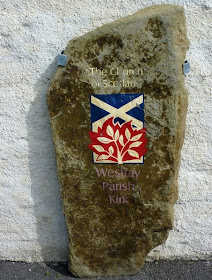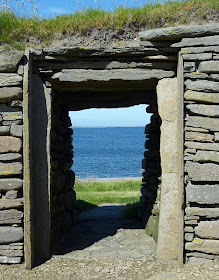Our first stop the next morning was at the West Manse, where the group saw how to make fatty cutties, and carried away several. Here is the recipe for fatty cutties, although Joan plans to substitute butter for margarine and see how that works. Long ago the original recipe used goose fat.
3 cups flour
½ lb margarine
pinch baking soda
1 cup currants
1 cup sugar
Cream margarine and sugar until soft. Add dry ingredients and the fruit. Mix to a soft dough. Rough out thinly and cut into squares or triangles. Bake on a hot griddle (not too hot!)
Our instructor and others melt the butter instead of creaming it; it's all in how you first learned to make them. Here's out it worked out in practice:
Needless to say, these treats were scrumptious, especially when still warm off the griddle. Each of us took away two or three in a paper sack, which soon developed those "dark stains that indicate freshness."
Next, Graham took us to visit the Westray Parish Church of the Church of Scotland.
A closeup of that stone.
The interior was lovely.
The church parking lot was a good viewpoint for taking in the setting of our hotel.
And where are we now?
We're at the Westray Airport, awaiting our flight to take us to Papa Westray, the adjacent island. The journey between Westray and Papa Westray requires two minutes or less in the air, and is the shortest scheduled airline flight in the world -- authenticated by Guinness World Records.
Our incoming plane approaches the runway.
We prepare to board.Our incoming plane approaches the runway.
The logo on the tail is that of the Highland Park Distillery, so there's some marketing going on that you wouldn't find in the USA. After we squeezed into the plane our pilot gave us the briefing. Flotation devices under the seat, meal service is either beef or chicken, and in-flight entertainment is either War and Peace or Gone With the Wind.
I recorded the entire flight.
On disembarking we each received a certificate attesting to our flight, and then our aircraft took off to return to Kirkwall.
LoganAir was very accommodating when Bernardo discovered that he had left his camera bag behind on the airplane, under his seat. The gear was retrieved from the plane, now hangared in Kirkwall, and flown to Papa Westray so it could be returned to him before we left the island. Bernardo was reunited with his equipment shortly after lunch. Now that's customer service!
There is also talk of incorporating this flight into an 18-hole golf course -- nine holes to be played on Papa Westray (there is already a 9-hole course there, if challenging), followed by the 2-minute flight and playing the back nine on Westray.
Our first visit on Papa Westray was to the Knap of Howar. This neolithic settlement is considered the oldest known in Orkney, and was occupied for about five centuries.
What has been excavated so far is not as extensive as Skara Brae, but it is in excellent condition.One doorway looks back towards the northern tip of Westray.
The Knap of Howar is reached by driving down a farm lane, on which we had an encounter of the bovine kind. Driving in, a loose youngster (not quite filled out yet) was in the lane, with no way to get out because of the gates at either end. She retreated before us, but couldn't back up any further once she reached the far gate. Our leader David stepped out of the mini bus, and his approach frightened the cow into sprinting past the bus. When we came back after visiting the Knap, our buddy was still there, and again backed up until she could go no further. This time, when David exited the bus, she jumped through a low stone fence topped with smooth (not barbed) wire, which she hung up in for a few seconds before wriggling free. Our local guide stopped at the farmhouse to let the farmer know that the cow was now in somewhere else on the farm.
We next visited St. Boniface Kirk, dating from the 12th Century, and one of the oldest Christian sites still extant in northern Scotland.
Here our guide pointed out some of the oldest parts of the church building.
The church is still in use. The youth group recently made tiles to create a scene from the life of St. Boniface, which decorates the gallery.
There is an unusual gravestone in the cemetery, a weathered hogback gravestone possibly of Norse origin.
After a hearty soup and sandwich lunch at the community center, we drove to North Hill, the northernmost quarter of the island, which is managed as a nature preserve jointly by the people of Papay, the RSPB, and Scottish Natural Heritage. In summer a warden is on site; the official warden was busy in the construction of a racing cart for an imminent Papa Westray festival, so his assistant -- very far away from her native New Zealand -- took us on tour. We each got a brochure.
We didn't have enough time to truly explore the reserve, but we got a good walk in, including Fowl Craig, a collection of cliffs with good nesting spots. Just watch your step near the edge.
Ever wondered why so many seabird eggs have an exaggerated point? It's probably an evolutionary development, so eggs laid on narrow cliff ledges won't roll off, but will merely roll in a tight circle.
We also bagged another puffin sighting.
Further down we passed several stone enclosures, or crues, used to pen geese and to grow vegetables, protecting them from the worst of the winds (Orkney is, after all, at 59° north latitude, barely south of Greenland).
After taking the ferry back to Westray, our group had some time to visit the Heritage Center and do some shopping. Remember the Orkney Venus? She might end up at a major museum, such as the Scottish National Museum, but for now she is on display at the Heritage Center in Pierowall, Westray, Orkney. Although she was enclosed in some type of plexiglas or polycarbonate, I was able to take my own picture of what the local islanders call the "Westray Wifie."
Our final stop of the day was at Noltland Castle, built by the unscrupulous 16th Century opportunist, plotter, and assassin, Gilbert Balfour, who was finally executed in 1576 for taking part in an assassination plot against the King of Sweden.
Although the castle passed through several ownerships, the west end of the third story was never roofed over.
There's always a sign to photograph and jog the memory (Google is also a great help). Historic Scotland does a good job.
The late afternoon sun gave me my best photograph of the indefatigable Graham Maben.Back at the Cleaton House Hotel, we had dinner and turned our thoughts to packing for our return to Kirkwall. The sticky toffee pudding was excellent, and the Australian in our group thought it had been made with golden syrup, an ingredient I hadn't heard of before. However, I would have one more opportunity to try the sticky toffee pudding at Lynnfield Hotel in Kirkwall before declaring a favorite.
In the fading light I took a picture of the Westray windmill.
The next day would be our last in Orkney.






























No comments:
Post a Comment
Comments may not appear immediately as they are moderated by the author to eliminate spam. Please, no commercial links!